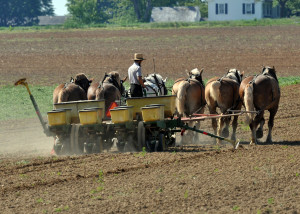Lessons From an Agricultural Preservation Leader: Lancaster County, Pennsylvania
Lancaster County, Pennsylvania is known for its well-regarded agricultural land preservation program. Located in southeastern Pennsylvania, the county of a half-million people uses plans and policies to support agriculture and other components of their economy.
The Lancaster County government has long recognized the importance of agriculture to the vibrancy of its community. Roughly 25% of the county’s entire land area is used as farmland—primarily for dairy, poultry, or specialty crop production. The majority of agriculture production efforts qualify as industrial or large-scale agriculture designated for distribution outside the county. However, the county is also home to Sect (Amish and Mennonite) farming operations: smaller-scale dairy and lucrative specialty crop productions including vegetables, bedding plants, etc. In addition there is an active community supported agriculture community.
Approximately 10.5% of the county’s population lives at or below the poverty level compared to 13.3% for the state of Pennsylvania. According to the Lancaster County Council of Churches, food banks and community rural providers in the County have reported an increase in the number of individuals and families seeking food assistance. Currently, the nonprofit community, rather than the county government, is largely addressing these challenges. There are a number of nonprofit and community groups that are tackling these issues through programs such as community supported agriculture and local food distribution options.
Since 2006, the county government has taken significant steps to support agriculture as essential to the vibrancy of the community. Listed below are a few of these programs and policies:
Agriculture and Rural Lands Planning Program. Lancaster County has one of the leading agricultural land preservation programs in the country, with approximately 25% of farmland (approximately 100,000 acres) under permanent conservation easement. The Agriculture and Rural Lands Planning Program was developed to help the county achieve the goals and implement the policies of the county’s growth management and green infrastructure elements of the comprehensive plan – Balance and Greenscapes, respectively.
- Balance: Adopted in 2006, Balance is the growth management element of the county’s comprehensive plan. This element is designed to help achieve and sustain Lancastrians’ vision of a balanced community where urban centers prosper, natural landscapes flourish, and farming is strengthened as an integral component of our diverse economy and cultural heritage.
- Greenscapes: Adopted in 2009, Greenscapes is the green infrastructure element of the county’s comprehensive plan. This element highlights the importance of protecting large blocks of contiguous land and improving connectivity to provide a blueprint for accommodating appropriate growth and development while preserving the region’s most valuable natural resources, native species, cultural assets, and agricultural economy
The Lancaster County Planning Commission (LCPC) oversees this program and a county government staff person, the Agricultural and Rural Planning Analyst, is responsible for program development and implementation. The program focuses on guiding county and municipal policy regarding agricultural and natural conservation, as well as sustaining the viability of the agricultural economy.
Agricultural Zoning District Guidelines for Lancaster County. While the LCPC has no regulatory authority over local governments within its boundaries, the LCPC provides guidance on how to implement the planning framework set by the county comprehensive plan. In 2010, the LCPC adopted agricultural zoning district guidelines that the 60 municipalities within the county can incorporate into their zoning code to ensure farmland is available for agriculture production. As a result of these guidelines, the rural townships have largely adopted what the LCPC refers to as “effective agricultural zoning,” which limits the amount of land that can be taken out of agricultural use. In addition, some local governments are getting involved through Transfer of Development Rights (TDR) programs, and some are funding their own preservation programs. The county government’s success is due in part to its stakeholder engagement in regional comprehensive planning efforts, particularly municipal officials and other decision-makers.
Blue Ribbon Commission on Agriculture. In addition to the county comprehensive plan, the Blue Ribbon Commission on Agriculture (BRCA) advances a proactive rural strategy, which goes beyond land preservation to support agriculture and other components of the rural economy. The Board of Lancaster County Commissioners established the BRCA in 2005 to find creative and innovative ideas to “ensure the viability of Lancaster County agriculture for years to come.” The BRCA serves as a citizens advisory body to County Commissioners on agricultural issues related to economic development, communications and leadership, farmland preservation, tax equity, and zoning. Over 100 citizens have been involved in various working groups.
Blueprints. Another innovative county plan is Blueprints, the Water Quality and Quantity Element of the Comprehensive Plan. Adopted in 2012, Blueprints addresses the impacts of agriculture on water quality, an important issue because of the County’s location within the Chesapeake Bay watershed.
The Lancaster agricultural community – both large and small-scale farmers – continue to face a number of economic, environment and cultural challenges. Most of the larger-scale operations ship raw products outside of the county to be processed elsewhere. The rising cost of land prices threatens the financial viability of crop-based farms, making it harder to make a living from just farming. Animal husbandry operations are required by the Chesapeake Bay Watershed Agreement to abide by strict nutrient loading regulations. While these regulations are clear for large-scale concentrated animal feeding operations, they are less clear for smaller scale farms.
Given these challenges, there is an opportunity for the county and municipal governments to support the expansion of local processing and distribution options within the county for larger farming operations, and the expansion of local and regional markets for smaller farming operations. The county government plans on addressing some of these challenges by encouraging local government to provide zoning and regulatory incentives. But, the county government also recognizes that connecting local food production to local consumption in an agricultural economy where most products are shipped out of the county will be a major challenge in the future.

